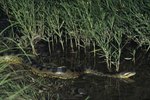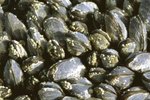Pond habitats are home to a diverse number of fish, insects and amphibians. The biodiversity within ponds is highly sensitive to pollution and human disruption of nesting areas. Shrinking pond habitats have resulted in some pond animals loosing the ability to naturally replenish their populations and caused them to become endangered and at risk of extinction.
Western Pond Turtle
Living in ponds, streams, lakes, and permanent wetlands, the Western Pond Turtle is listed by Washington state as an endangered species. The turtle spends most of its time in the water, but it needs access to undisturbed land when it nests, usually within 100 yards of water. The decline of the Western Pond Turtle occurred during commercial hunting of the animal, which destabilized the fragile population. Western Pond Turtles have low rates of births, meaning their population never really recovered from commercial exploitation. Shrinking pond habitats due to land development has also contributed to the species becoming endangered, as well as increased bull frog populations, which prey on the turtle species.
Yellow Spotted Tree Frog
The Yellow Spotted Tree Frog, also known as the New England Swamp Frog, is a critically endangered species. The frog is eight centimeters in length and lives in ponds, rivers, lakes, and dams, preferring areas with lots of vegetation. Breeding takes place during spring and summer months near large ponds. Right now, Frogs Australia estimates that there are less than 1,000 remaining adult species of this frog. Reasons for endangerment include pesticides and insecticides making their way into ponds; degraded water supply due to pollution; diseases; and human interference in natural habitats.
Plymouth Red-bellied Turtle
The Plymouth Red-bellied Turtle occupies ponds, lakes, rivers, and shorelines. The turtle is known for its limited range of habitat selection, one of the reasons why it has become endangered. Confined to a small area of Plymouth County, Mass., the turtle needs undisturbed land for its nests and usually nests during the spring months. Nesting is done within 90 yards of a pond or body of water. Most of the population's destabilization is from the nesting areas being disturbed by human populations, and from hunting by skunks and raccoons.
References
Photo Credits
-
pond image by adelacuesta from Fotolia.com
Writer Bio
Alexander Sam is an avid photographer/traveler. After completing a trip across India, Thailand and Laos he decided that he wasn't made for the cubicle job. Presently he is backpacking across South America and hopes to find himself in another part of the world at this time next year. Sam studied sociology at York University.





